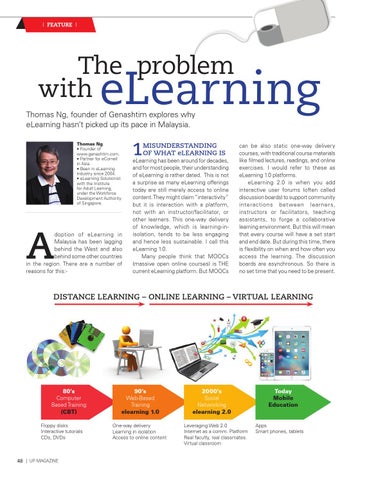I FEATURE I
The problem with
eLearning
Thomas Ng, founder of Genashtim explores why eLearning hasn’t picked up its pace in Malaysia.
1
MISUNDERSTANDING OF WHAT eLEARNING IS
Thomas Ng • Founder of www.genashtim.com. • Partner for eCornell in Asia. • Been in eLearning industry since 2004. • eLearning Solutionist with the Institute for Adult Learning, under the Workforce Development Authority of Singapore.
A
doption of eLearning in Malaysia has been lagging behind the West and also behind some other countries in the region. There are a number of reasons for this:-
eLearning has been around for decades, and for most people, their understanding of eLearning is rather dated. This is not a surprise as many eLearning offerings today are still merely access to online content. They might claim “interactivity” but it is interaction with a platform, not with an instructor/facilitator, or other learners. This one-way delivery of knowledge, which is learning-inisolation, tends to be less engaging and hence less sustainable. I call this eLearning 1.0. Many people think that MOOCs (massive open online courses) is THE current eLearning platform. But MOOCs
can be also static one-way delivery courses, with traditional course materials like filmed lectures, readings, and online exercises. I would refer to these as eLearning 1.0 platforms. eLearning 2.0 is when you add interactive user forums (often called discussion boards) to support community interactions bet ween learners, instructors or facilitators, teaching assistants, to forge a collaborative learning environment. But this will mean that every course will have a set start and end date. But during this time, there is flexibility on when and how often you access the learning. The discussion boards are asynchronous. So there is no set time that you need to be present.
DISTANCE LEARNING – ONLINE LEARNING – VIRTUAL LEARNING
80’s Computer Based Training (CBT) Floppy disks Interactive tutorials CDs, DVDs
48 | UP MAGAZINE
90’s Web-Based Training elearning 1.0 One-way delivery Learning in isolation Access to online content
2000’s Social Networking elearning 2.0 Leveraging Web 2.0 Internet as a comm. Platform Real faculty, real classmates. Virtual classroom
Today Mobile Education
Apps Smart phones, tablets
